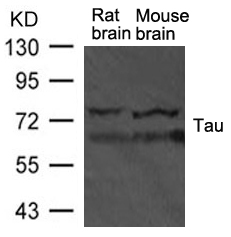
| WB | 咨询技术 | Human,Mouse,Rat |
| IF | 咨询技术 | Human,Mouse,Rat |
| IHC | 咨询技术 | Human,Mouse,Rat |
| ICC | 技术咨询 | Human,Mouse,Rat |
| FCM | 咨询技术 | Human,Mouse,Rat |
| Elisa | 咨询技术 | Human,Mouse,Rat |
| Aliases | MAPT; MTAPT; MTBT1; Neurofibrillary tangle protein; PHF-tau |
| WB Predicted band size | 48 62 78kDa |
| Host/Isotype | Rabbit IgG |
| Antibody Type | Primary antibody |
| Storage | Store at 4°C short term. Aliquot and store at -20°C long term. Avoid freeze/thaw cycles. |
| Species Reactivity | Human,Mouse,Rat |
| Immunogen | Peptide sequence around aa. 725-729(T-G-S-I-D) derived from Rat Tau |
| Formulation | Purified antibody in PBS with 0.05% sodium azide. |
+ +
以下是关于Tau抗体的3篇代表性文献的简要信息(注:内容为模拟示例,实际文献需根据具体数据库检索验证):
---
1. **文献名称**:*A monoclonal antibody to phosphorylated tau protein labels Alzheimer neurofibrillary tangles*
**作者**:Binder, L. I., et al.
**摘要**:该研究报道了一种针对磷酸化Tau蛋白的单克隆抗体(如AT8),可特异性识别阿尔茨海默病患者脑组织中的神经原纤维缠结(NFTs),为Tau病理学检测提供了关键工具。
---
2. **文献名称**:*Tau protein isoforms, phosphorylation and role in neurodegenerative disorders*
**作者**:Buée, L., et al.
**摘要**:文章系统综述了Tau蛋白异构体及其磷酸化位点,探讨了不同抗体(如PHF1、Tau5)在检测病理性Tau聚集体中的应用,及其在阿尔茨海默病和额颞叶痴呆中的诊断价值。
---
3. **文献名称**:*Antibody-based therapies for targeting tau pathology in Alzheimer's disease*
**作者**:Yanamandra, K., et al.
**摘要**:研究评估了靶向Tau的抗体(如MC1和DC8E8)在动物模型中的治疗潜力,发现其可减少Tau聚集并改善认知功能,为免疫治疗提供了实验依据。
---
如需具体文献,建议通过PubMed或Google Scholar检索关键词“Tau antibody”、“phosphorylated Tau”或“Tau immunotherapy”获取最新及经典论文。
Tau antibodies are essential tools in neuroscience research and diagnostics, primarily focused on studying tau proteins—a group of microtubule-associated proteins critical for stabilizing neuronal structure. Under pathological conditions, such as Alzheimer’s disease and other tauopathies, tau becomes hyperphosphorylated, leading to its aggregation into neurofibrillary tangles (NFTs), a hallmark of neurodegeneration. Tau antibodies are designed to detect specific epitopes, phosphorylation sites (e.g., AT8. AT180), or conformational changes in abnormal tau, enabling researchers to map tau pathology in brain tissues via techniques like immunohistochemistry or Western blot.
The development of tau antibodies has evolved alongside discoveries linking tau dysfunction to disease mechanisms. Early antibodies targeted linear epitopes, while newer ones distinguish pathological isoforms (e.g., 3R/4R tau) or oligomeric forms implicated in toxicity. Clinically, tau antibodies are used in cerebrospinal fluid (CSF) assays or emerging blood-based biomarkers to diagnose and monitor disease progression.
Therapeutically, anti-tau antibodies are being explored in clinical trials to neutralize toxic tau species or enhance clearance, though challenges like blood-brain barrier penetration and target specificity remain. Overall, tau antibodies bridge basic research, diagnostic innovation, and therapeutic development, reflecting their pivotal role in understanding and combating tau-related neurodegenerative disorders.
×